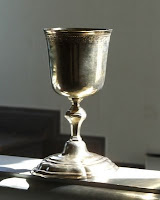In my previous Journal entry, I shared my thoughts about the bread at the Last Supper. (If you missed it, you can read it here.) Today I’m continuing my ponderings, and I invite you to consider the cup. More specifically, the cups, because in a traditional Passover celebration (called a Seder) there are four. Each cup represents one of the “I Wills” of God, the promises He made to the Hebrew people when He declared that He would lead them out of slavery in Egypt. Those promises are found in Exodus 6:6-7:
- I WILL bring you out from under the yoke of the Egyptians
- I WILL free you from being slaves to them
- I WILL redeem you with an outstretched arm and with mighty acts of judgment
- I WILL take you as my own people, and I will be your God
The four cups of wine are interspersed throughout the evening, and each is drunk at a specific time. The first cup, along with a blessing, is the official beginning of the meal. We read in Luke 22:17 that Jesus took the cup – that would be the first cup, the cup of sanctification, or “bringing out” – and gave thanks. Then he broke from the traditional ritual of the meal, because he didn’t drink. Instead, he told his disciples to divide the wine among themselves. I’m sure Biblical scholars know why Jesus did this. I’m not a scholar by any stretch of the imagination, but I think one reason may have been this: he is the one who sanctifies us. He brings us out from the rest of the world, sets us apart and consecrates us for his purposes. It’s something he does for us, and giving his wine to his disciples that night symbolized his act of sanctification in the lives of each one of us. I like imagining myself seated (or reclining) at that table with him, receiving sanctification from his hand.
After the first cup, we can assume that the Last Supper continued in the order of the traditional Passover celebration. Luke seems to have paid special attention to recording the places where the events of the evening diverged from tradition. So Jesus and his apostles recited blessings, performed ritual hand washings, broke the bread, told the story of God’s miraculous deliverance, and ate a big, traditional meal. The next cup mentioned is in verse 20. It says after the supper, he took the cup saying, “This is the new covenant in my blood, which is poured out for you.” In the traditional order of a Passover Seder celebration, the cup drank after supper is the third cup, the cup of redemption. It represents God’s third “I Will” promise:
I WILL redeem you with an outstretched arm and with mighty acts of judgment
The cup of redemption is the cup that Jesus identified as the new covenant in his blood. When I realized that, chills raced up and down my arms. You see, Jesus knew every detail of what was coming. He knew that he was about to fulfill that promise of redemption, that “I Will” made centuries before by the great I Am. And he was about to do it literally – with outstretched arms, on the cross.
My friends, I invite you to drink from the cups that Jesus offers. Be sanctified to his service. Be set free from whatever enslaves you. Be redeemed through his mighty acts. And become fully and completely his.
(Stay tuned – I have more thoughts to share on the Last Supper!)

